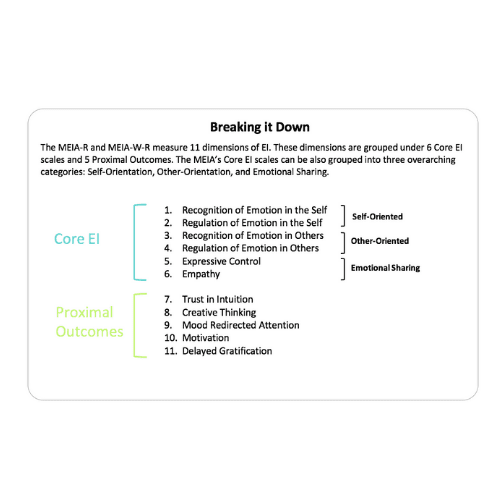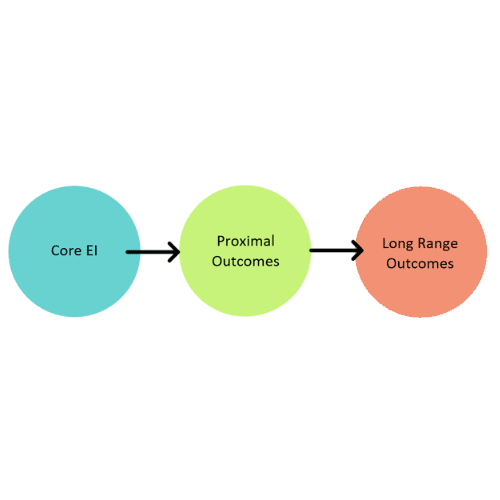Understanding the Dimensions of EI (Emotional Intelligence)
The Multidimensional Emotional Intelligence Assessment (MEIA) is a short self-assessment measuring emotional intelligence (EI). This year, SIGMA introduced the MEIA-R (Revised) and the MEIA-W-R (MEIA – Workplace – Revised). These updated assessments have broader coverage, revised content, and a shorter administration time than the original MEIA and MEIA-W, while also maintaining high construct validity.
Along with introducing these new assessments, we’d like to take a moment to explain two important terms used throughout the MEIA-R and MEIA-W-R reports – Core EI and Proximal Outcomes.
A Brief History of the MEIA
The original version of the MEIA was developed in 2006, based on Mayer and Salovey’s influential model of EI (1990). The MEIA takes a multidimensional approach to measuring EI. This means that it breaks EI down into multiple components rather than treating it as a general construct. Defining EI in this way is beneficial because it allows for a more targeted diagnostic profile and therefore allows individuals to identify specific strengths or opportunities for development. The MEIA-R and MEIA-W-R each define 11 distinct dimensions of EI. These dimensions consist of 6 Core EI scales and 5 Proximal Outcomes.

Did You Know?
There are two different approaches to measuring EI: 1) Ability-based and 2) Trait-based. Ability EI measures how well an individual can process emotional information. Ability EI is related to, but distinct from cognitive ability. The second approach to EI is measuring it as a “trait.” Trait EI is a personality construct and refers to an individual’s tendency to act in an emotionally intelligent manner, regardless of their level of ability.
The distinction between trait and ability EI is important because individuals may be able to recognize and respond to emotions (ability EI), but without the willingness to do so (trait EI), others are unlikely to benefit from their high EI. For this reason, the MEIA measures EI as a trait, rather than an ability.
Core EI vs Proximal Outcomes
When we think of EI we tend to think of things like regulating our emotions and understanding the emotions of others. These are the fundamental building blocks of EI and are referred to as Core EI dimensions on the MEIA-R and MEIA-W-R. Proximal Outcomes, on the other hand, are the ways in which we can apply EI, both in our personal lives and in the workplace. These applications include our ability to make good decisions, solve problems, and pursue important life goals.
Core EI dimensions and Proximal Outcomes are related to one another, such that Core EI dimensions impact Proximal Outcomes. For example, the core construct of empathy is related to creativity. Being empathetic means feeling others’ experiences and emotions as if they were your own. This tendency to empathize with others is also associated with taking the perspective of others. Taking time to consider others’ experiences and how they may be feeling can help to facilitate creative thinking as you search for a solution that meets others unique needs.
Just as Core EI influences Proximal Outcomes, Proximal Outcomes influence long range outcomes. Long range outcomes of EI include greater life satisfaction, self-esteem, job satisfaction, job performance, and academic performance. Studies have shown that EI relates meaningfully to these and other advantageous life outcomes.[1]

Want to Learn More?
For over 50 years, SIGMA has been a leader in assessment and executive development. We offer coaching and consulting services that are supported by our range of leadership development, employee selection, career interest, and personality assessments. Contact us below to learn how we can help your team today.
[1] Tett, R.P., Wang, A., Fox, K.E. (2006). Multidimensional Emotional Intelligence Assessment: Technical Manual. [PDF]. SIGMA Assessment Systems, Inc.